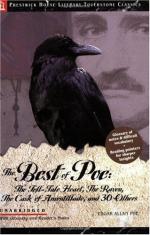In the following pages, we have a fresh example of an artist’s genius characterizing his interpretation of a famous poem. Gustave Dore, the last work of whose pencil is before us, was not the painter, or even the draughtsman, for realists demanding truth of tone, figure, and perfection. Such matters concerned him less than to make shape and distance, light and shade, assist his purpose,—which was to excite the soul, the imagination, of the looker on. This he did by arousing our sense of awe, through marvellous and often sublime conceptions of things unutterable and full of gloom or glory. It is well said that if his works were not great paintings, as pictures they are great indeed. As a “literary artist,” and such he was, his force was in direct ratio with the dramatic invention of his author, with the brave audacities of the spirit that kindled his own. Hence his success with Rabelais, with “Le Juif-Errant,” “Les Contes Drolatiques,” and “Don Quixote,” and hence, conversely, his failure to express the beauty of Tennyson’s Idyls, of “Il Paradiso,” of the Hebrew pastorals, and other texts requiring exaltation, or sweetness and repose. He was a born master of the grotesque, and by a special insight could portray the spectres of a haunted brain. We see objects as his personages saw them, and with the very eyes of the Wandering Jew, the bewildered Don, or the goldsmith’s daughter whose fancy so magnifies the King in the shop on the Pont-au-Change. It was in the nature of things that he should be attracted to each masterpiece of verse or prose that I have termed unique. The lower kingdoms were called into his service; his rocks, trees and mountains, the sky itself, are animate with motive and diablerie. Had he lived to illustrate Shakespeare, we should have seen a remarkable treatment of Caliban, the Witches, the storm in “Lear”; but doubtless should have questioned his ideals of Imogen or Miranda. Beauty pure and simple, and the perfect excellence thereof, he rarely seemed to comprehend.




